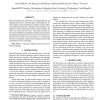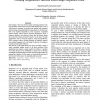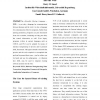3371 search results - page 56 / 675 » Using parsimonious language models on web data |
ICASSP
2009
IEEE
15 years 1 months ago
2009
IEEE
Speech recognition of inflectional and morphologically rich languages like Czech is currently quite a challenging task, because simple n-gram techniques are unable to capture impo...
101
click to vote
CORR
2010
Springer
14 years 10 months ago
2010
Springer
Data mining is the task of discovering interesting patterns from large amounts of data. There are many data mining tasks, such as classification, clustering, association rule mini...
BIRTHDAY
2006
Springer
15 years 1 months ago
2006
Springer
The Semantic Web (SW) is viewed as the next generation of the Web that enables intelligent software agents to process and aggregate data autonomously. Ontology languages provide ba...
COMPSAC
2002
IEEE
15 years 2 months ago
2002
IEEE
:The eXtensible Markup Language – XML – is not only a language for communication between humans and the web, it is also a language for communication between programs. Rather th...
WWW
2006
ACM
15 years 10 months ago
2006
ACM
Web Clustering is useful for several activities in the WWW, from automatically building web directories to improve retrieval performance. Nevertheless, due to the huge size of the...



